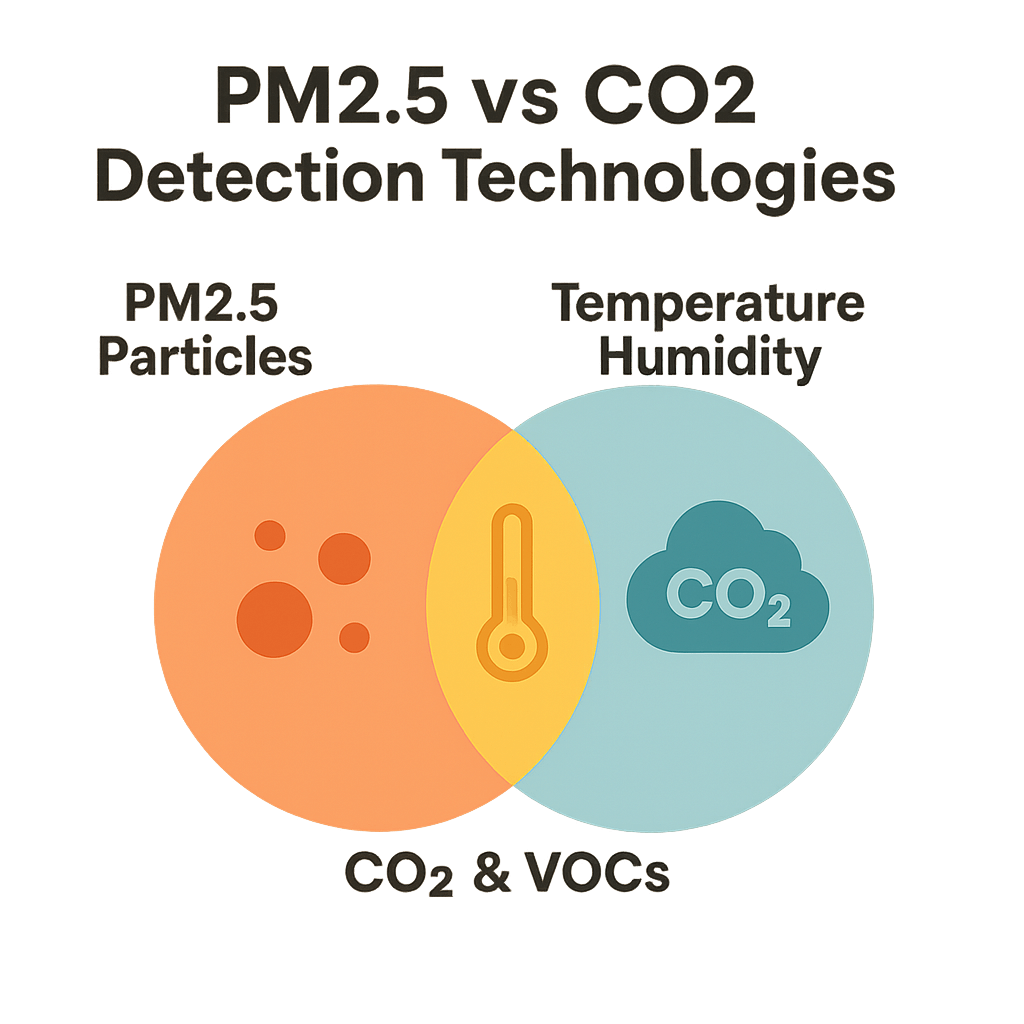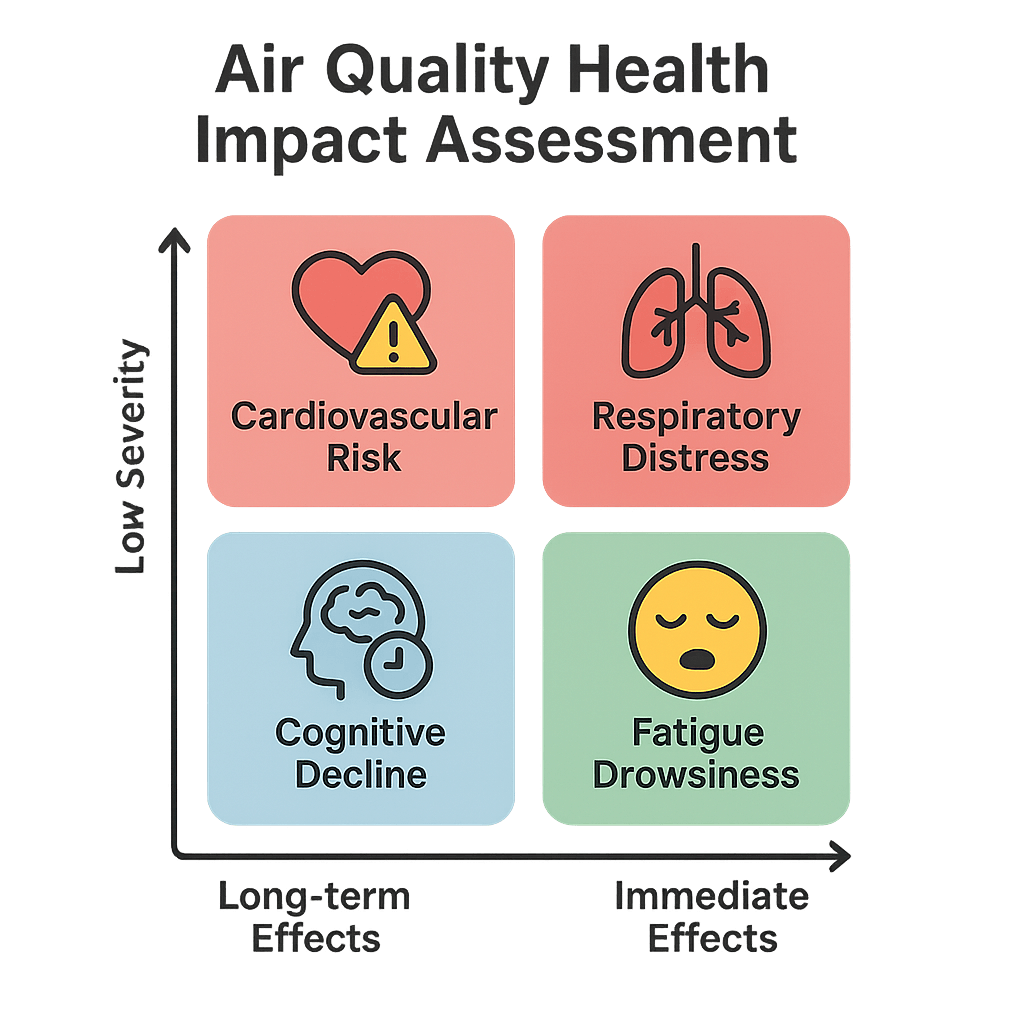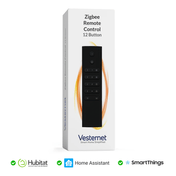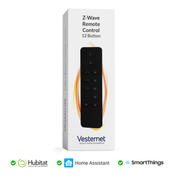Indoor air quality has become a critical concern for homeowners, with rising awareness of how airborne pollutants and gases affect health, comfort, and productivity in our living spaces. Poor air quality can trigger respiratory issues, reduce cognitive function, and create uncomfortable living conditions that impact our daily wellbeing.
This comprehensive comparison will help you choose between MCO Home's PM2.5 particle monitor and CO2 sensor, examining their unique monitoring capabilities and smart air quality integration features. Both devices offer Z-Wave Plus connectivity, enabling seamless integration with your existing home automation system for responsive environmental control.
As a leading Z-Wave specialist, Vesternet provides expert insights into both devices' real-world performance, helping you make an informed decision for your air quality monitoring needs. Understanding the distinct advantages of particle versus gas detection will guide you towards the most suitable indoor air quality monitor for your specific environment.
Understanding Particle vs Gas Detection Technology
The MCO Home PM2.5 monitor specialises in detecting fine particulate matter suspended in the air, measuring particles with diameters of 2.5 micrometers or smaller. These microscopic particles include dust, pollen, smoke, and pollution that can penetrate deep into your respiratory system, making accurate detection crucial for health-conscious homeowners.
Key PM2.5 Detection Features
- Measures particles from 0-999.9 µg/m³ with high precision
- Monitors temperature (-9.0 to 50°C) and humidity (0-99% RH)
- 230V mains power supply ensures consistent operation
- Wall-mounted design with vertical orientation requirement
- Z-Wave Plus protocol for reliable smart home integration
The device requires installation at approximately 1.5m height, away from direct sunlight and heat sources to maintain detection accuracy. This air quality detector provides continuous monitoring of the particle pollution that affects respiratory health and indoor comfort levels.
CO2 and Multi-Gas Monitoring Capabilities
MCO Home's CO2 sensor takes a different approach, focusing on carbon dioxide levels that indicate ventilation effectiveness and air freshness. This indoor air quality monitor also measures temperature and humidity whilst offering optional volatile organic compound (VOC) detection for comprehensive gas monitoring capabilities.
CO2 Sensor Detection Range
- Carbon dioxide concentration monitoring for ventilation assessment
- Optional VOC detection for chemical pollutant awareness
- Temperature and humidity sensing for complete environmental data
- 12V power supply offers flexible installation options
- Z-Wave Plus connectivity enables automated responses
The sensor operates on a 12V power system, providing installation flexibility compared to mains-powered alternatives. Like the PM2.5 monitor, it requires positioning at 1.5m height away from heat sources and direct sunlight for optimal performance in residential and commercial environments.

Pollutant Types and Health Impact Monitoring
Understanding the fundamental differences between particle and gas detection helps determine which air quality detector suits your specific health and comfort priorities. PM2.5 particles pose immediate respiratory risks, whilst CO2 and VOC gases affect cognitive function and overall air freshness through different pathways.
PM2.5 Particle Health Impacts
- Triggers asthma and allergic reactions in sensitive individuals
- Penetrates deep into lung tissue causing inflammation
- Links to cardiovascular issues with long-term exposure
- Particularly problematic in urban environments with traffic pollution
Fine particles bypass the body's natural filtration systems, making continuous monitoring essential for maintaining healthy indoor environments. The PM2.5 monitor excels in detecting these microscopic threats that often remain invisible until health symptoms emerge.
CO2 and VOC Gas Effects
- Elevated CO2 reduces concentration and decision-making abilities
- Poor ventilation leads to stuffiness and drowsiness
- VOC exposure causes headaches and respiratory irritation
- High gas concentrations indicate inadequate fresh air circulation
Gas monitoring addresses ventilation quality and chemical pollutants that affect cognitive performance and comfort. The CO2 sensor provides early warning of inadequate air circulation before occupants notice stuffiness or reduced mental clarity.
Both devices integrate seamlessly with Z-Wave Plus networks, enabling automated ventilation responses, air purifier activation, and environmental data logging. The choice between particle and gas detection depends on your primary health concerns and the pollutant sources most prevalent in your specific indoor environment.

Real-World Detection Accuracy and Response Times
Both monitors demonstrate impressive accuracy within their specialised detection ranges, though response times vary based on the physical properties of particles versus gases. The PM2.5 monitor provides rapid particle detection within minutes, whilst the CO2 sensor offers consistent gas concentration readings with slightly longer equilibration periods.
PM2.5 Monitor Performance Characteristics
- Detection range covers typical indoor concentrations effectively
- Quick response to cooking smoke, cleaning products, and outdoor pollution
- Stable readings once properly calibrated and positioned
- Weather-sealed design maintains accuracy in varying humidity conditions
The particle monitor excels in environments where rapid detection matters most, such as during cooking activities or when outdoor pollution enters through windows. Its 230V power supply ensures consistent performance without battery-related accuracy variations.
CO2 Sensor Reliability Factors
- Consistent carbon dioxide measurements across typical indoor ranges
- VOC detection adds chemical pollutant awareness capabilities
- Temperature compensation maintains accuracy across seasons
- 12V power system reduces electrical interference issues
The gas sensor provides reliable long-term monitoring with minimal maintenance requirements. Its multi-parameter detection gives comprehensive air quality insights, though individual gas readings may take slightly longer to stabilise compared to particle detection. Both devices maintain Z-Wave Plus communication reliability for consistent smart air quality system integration.

PM2.5 Monitor: Particle Detection Strengths and Limitations
The PM2.5 monitor excels in detecting fine particles that directly impact respiratory health, making it invaluable for allergy sufferers and households near traffic or industrial areas. Its 230V mains power connection ensures reliable operation without battery maintenance, whilst the precise measurement range covers typical indoor particle concentrations effectively.
Primary Advantages
- Targets the most health-critical particle size range
- Mains power eliminates battery replacement concerns
- High measurement precision for accurate health assessments
- Ideal for urban environments with outdoor pollution infiltration
The monitor's specialisation in PM2.5 detection provides focused insights into the particles most likely to cause respiratory issues. However, this narrow focus means other air quality factors require additional monitoring devices for comprehensive environmental awareness.
Potential Limitations
- Requires 230V electrical connection limiting placement flexibility
- Focuses solely on particles, missing gas-phase pollutants
- Installation complexity increases with mains power requirements
Whilst the air quality detector provides excellent particle monitoring, it cannot detect carbon dioxide or chemical vapours that affect air freshness and cognitive function. The mains power requirement also restricts installation locations compared to low-voltage alternatives.

CO2 Sensor: Gas Monitoring Advantages and Considerations
The CO2 sensor addresses ventilation quality and air freshness through gas-phase detection, making it particularly valuable for home offices, bedrooms, and spaces where cognitive performance matters. The 12V power system offers installation flexibility, whilst optional VOC monitoring extends detection capabilities beyond carbon dioxide alone.
Key Benefits
- Monitors ventilation effectiveness through CO2 tracking
- Optional VOC detection identifies chemical pollutants
- 12V power supply enables flexible placement options
- Multi-parameter sensing provides comprehensive gas analysis
This indoor air quality monitor excels in identifying poor ventilation before occupants notice discomfort, enabling proactive environmental management. The device particularly suits modern airtight homes where natural air exchange may be insufficient for optimal air quality.
Monitoring Scope Considerations
- Focuses on gases rather than particulate matter
- 12V power system requires appropriate supply source
- VOC detection remains optional rather than standard
Whilst the sensor provides excellent gas monitoring capabilities, it cannot detect the fine particles that cause respiratory issues in sensitive individuals. The 12V power requirement, though more flexible than mains voltage, still requires careful planning for optimal placement and reliable operation within your smart air quality monitoring system.
Choosing Based on Your Air Quality Priorities
Your choice between these air quality detectors depends primarily on the pollutant sources and health concerns most relevant to your living environment. Urban dwellers facing outdoor pollution infiltration will benefit more from PM2.5 monitoring, whilst those in well-sealed modern homes may prioritise CO2 and VOC detection for ventilation management.
PM2.5 Monitor Best Suited For
- Households with asthma or allergy sufferers
- Urban locations with traffic or industrial pollution
- Homes near construction sites or dusty environments
- Properties requiring focused particle health monitoring
The particle monitor provides critical health information for respiratory-sensitive individuals, particularly in environments where outdoor pollution regularly enters indoor spaces. Its precise PM2.5 detection helps maintain healthy air quality standards for vulnerable household members.
CO2 Sensor Ideal Applications
- Home offices requiring optimal cognitive performance
- Modern airtight homes with limited natural ventilation
- Bedrooms where sleep quality depends on fresh air
- Commercial spaces needing ventilation monitoring
The gas sensor excels in environments where air freshness and ventilation effectiveness directly impact comfort and productivity. Its multi-parameter monitoring provides comprehensive insights into air quality factors that affect daily life quality beyond just health concerns.
Both devices integrate seamlessly with Z-Wave Plus smart home systems, enabling automated responses such as ventilation fan activation, air purifier control, and environmental data logging. Consider your primary air quality concerns, installation constraints, and monitoring priorities when selecting between these specialised indoor air quality monitors.
For comprehensive coverage, some homeowners choose both devices to monitor particles and gases simultaneously, creating a complete air quality management system that addresses all major indoor pollutant categories through coordinated smart air quality automation.
Making the Right Choice for Your Indoor Environment
Both MCO Home monitors excel in their specialised detection areas, with the PM2.5 monitor focusing on fine particles that affect respiratory health, while the CO2 sensor addresses ventilation and air freshness concerns. Your choice ultimately depends on which air quality factors matter most in your specific living environment and health priorities.
Consider the PM2.5 monitor if you're concerned about dust, pollen, smoke, or live in urban areas with outdoor pollution infiltration. The CO2 sensor suits those prioritising ventilation monitoring, working from home environments, or wanting broader gas detection capabilities with optional VOC monitoring for chemical pollutant awareness.
Both devices integrate seamlessly into Z-Wave Plus smart home systems, providing valuable automated responses to air quality changes and comprehensive environmental data for informed decision-making. Explore both monitors to discover which aligns best with your health priorities and home automation goals for optimal indoor air quality management.


















